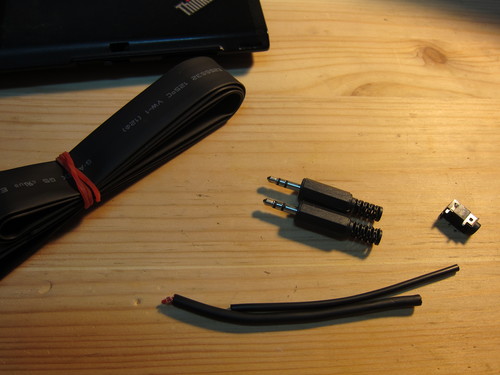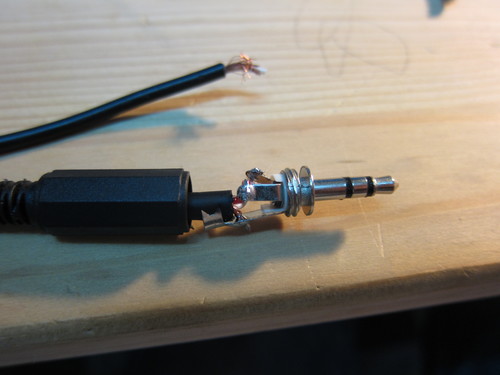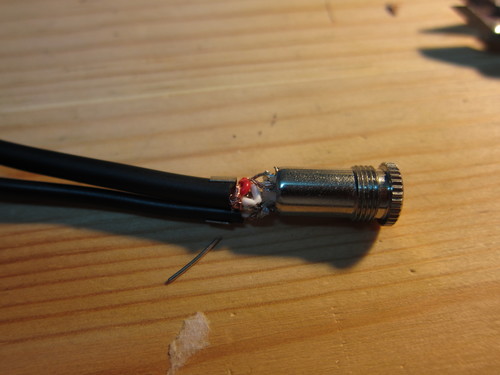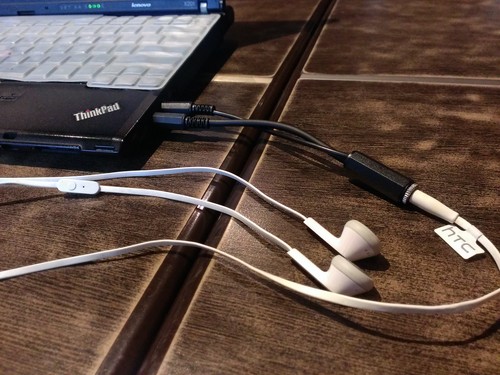My involvement in the Taipei Hackerspace so far had two very beneficial effect on my thinking: first I have much more ideas what new things to create, then I have much higher probability of seeing those projects through to completion. This post is a write-up of a recent project, illustrating both of these points.
About two weeks ago, I have fixed a headphone for a friend: the wire near the jack was broken and needed replacement. It was a relatively straightforward project, but needed a bit of digging into audio wires and jack connections. I was really proud of the result (fixing things have this effect, I highly recommend doing more of that!), and kept thinking if I can come up with any other audio-related project where I can use the knowledge I learned, and this is what I have came up with:
I bring my laptop almost everywhere with me, and started to use my smartphone headset to listen to music since it sounds great and much lighter to bring with me than the large headphones. It also has a built in microphone, so if I can use that, then really don’t need any other equipment to make Skype/Google+ Hangout calls. Those are 4-conductor headphones for Left/Right/Ground/Microphone channels, but computers (PCs) can only use the 3-conductor Left/Right/Ground and Mic/Mic/Ground connectors. Let’s make an adapter so I can break out the audio lines and mic lines to the appropriate laptop connectors!
Hardware setup
The parts needed:
- 1pc 4-conductor input socket
- 2pc 3-conductor output jack
- 1pc 1-signal (mono) audio wire (signal + ground lines), about 15cm per finished adapter
- 1pc 2-signal (stereo) audio wire (2 signals + ground), same length
The Guanghua Computer Market and its neighbourhood has a lot of electronics stores. The appropriate output 3-conductor jacks were really easy to find, as were the audio cables. Those didn’t look as good as the Bose headphone that I repaired, but it’s good for a prototype. The hardest part was the 4-conductor input socket: they had some that should be mounted on a printed circuit board, and tried that one for the first prototype, but then they found me some better one that I can use with the cables. That was the most expensive part at about 20TWD ($0.70).

Above is the circuit schematic, probably a bit of a mess, but tried to keep it simple. Then aim of the whole setup is to get the G (ground) + M (mic) lines to one jack (the mono audio, thinner cable), and G + L (left) + R (right) to another (stereo audio, ticker cable).
One complication is that the order of M-G-R-L seems to be the “Apple Way”, that my HTC headphone adopted as well, while others have a more logical (and easier to solder) G-M-R-L series (eg. the Sony PSP headphones as I found searching for it). Thus this adapter would not work for every headphone. Maybe version 3 should have a switch to swap the Mic and Ground lines at the input socket?

After all the parts are collected, there’s some micro-surgery. Strip the audio wires carefully, and don’t have to leave much out, just enough to get to the jack electrodes, and such that the thick outside cover fits into the cramp that is there to hold things in place.
For the microphone wire, connect the two output channels (the tip and the 2nd ring), and the ground goes to the base one. For the audio output, the tip is the left channel, the 2nd ring is the right, and the base is ground. The audio wire I got was a bit thick to cramp, but it’s not too bad if the metal cuts into the plastic cover, as long as it doesn’t cut through it.

The input socket was quite a bit trickier to solder, because the electrodes were so tiny. They are arranged in a 4 directions, going around clockwise as “tip – 2nd ring – 3rd ring – base”. Had to use some magnifying glass and one spare unsoldered jack to make sure I connect the right things to the right places, but it works – mostly. The hardest part is not to melt the individual wire insulation (they are not enameled wired as inside the manufactured headphones). Also, cramping the two wire together is tougher, had to cut off the sleeve of the socket so the wires fit within the plastic cover of the socket.

This second version was done within about 15-20 minutes, though, since I had all most of the research done previously. Had to do some careful inspection that no shorts developed within the device because of the soldering, and then connect everything up.

The listening sound quality is pretty good, though I guess it could be improved with better soldering (which includes using a finer tip soldering iron), and more patient cabling work. The mic is pretty nice, my recordings sound much better than before, and it’s convenient to use too. Much less thing to carry around and definitely better than my laptop’s built in mic. This might even get me to make more calls (sorry Mum and Dad that I haven’t been phoning too much lately!)
Taking it further
The electronic markets here in Taiwan are full of gadgets, and I looked but couldn’t really see any commercial adapter that did the same thing. This made me think that maybe it could be interesting to make this into an actual product. First find some local factories that could make it, as I keep hearing my business-related friends manufacturing a lot of things. Then set up a Kickstarter/Indiegogo project with some reasonable (let’s call it hobby-level) financial goal, and see whether people would be interested.
This would need quite a bit of preparation, and what’s putting me off is the simplicity of the project (what’s too simple for Kickstarter?), and that a Chinese factory could rip it off faster then you can say Shenzhen. Still, it might worth it for the experience and contacts, will do some research, and in the meantime keep making stuff that interests me.
Update 8/6: as a commenter pointed out, these things exists already e.g. on Amazon, searching for “smartphone headset pc adapter”. I guess that simplifies the future a bit, have more time for better projects.